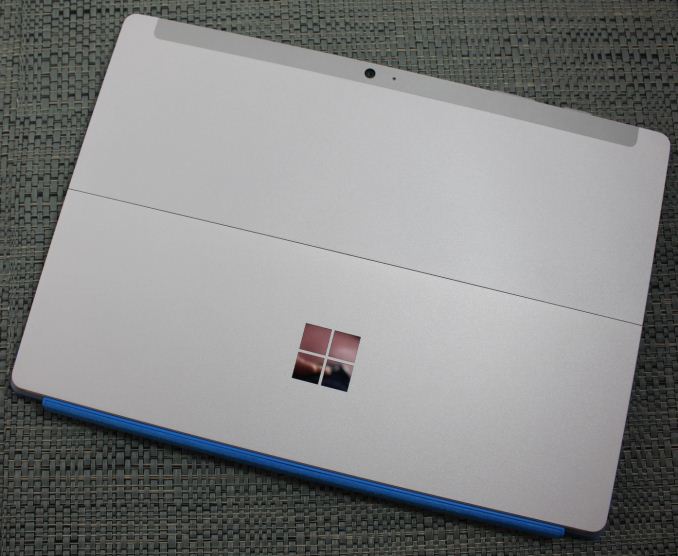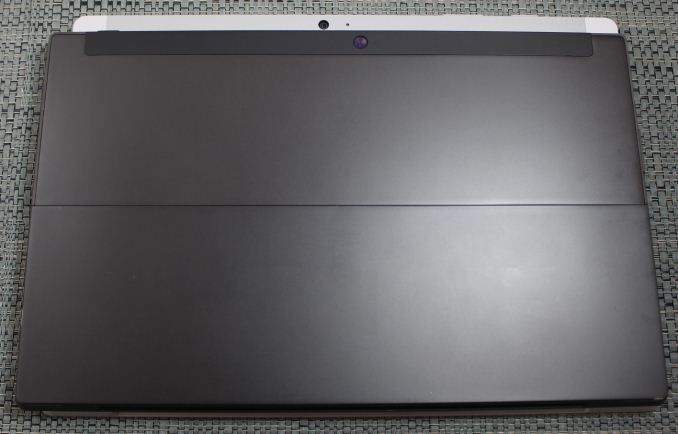The Surface 3 Review
by Brett Howse on May 4, 2015 9:00 AM EST
The Surface lineup for Microsoft has been extremely interesting to watch. What first launched in October 2012 as the Surface RT has been constantly iterated upon, and of course the Surface Pro line has evolved even faster. Surface Pro 3 has finally provided Microsoft with something that critics and consumers alike seem to have bought in to, and sales have been very strong since the Pro 3 was launched on May 20th 2014. However there has always been questions about the “consumer” version of Surface. Surface RT was, frankly, a sales disaster. The much improved Surface 2 fixed many of its shortcomings, but certainly did not set the world on fire. So now we have the third generation Surface, aptly named the Surface 3. There are a pile of changes that Microsoft has made to this generation of device, and obviously their hopes are that Surface 3 will be as popular as the Surface Pro 3 has been, but extending the device back down to a lower price point.
That price point is important. As much as the Surface Pro 3 has gained its share of fans, it is far from cheap. The most inexpensive model starts at $799, and for that you still do not get the keyboard. Surface 3 moves that bar down significantly, and the starting price is the exact same as the original Surface RT, at $499. Microsoft had to trim down the Pro model to hit this price point, but the cuts were well placed.
 Surface RT compared to Surface 3
Surface RT compared to Surface 3
I think looking at the Surface 3 in a vacuum would be improper, since the device now is really an evolution of the previous two Surface models. From a build quality standpoint, the original Surface RT was top notch, with its VaporMg case, the revolutionary kickstand, and high attention to detail for all of the aspects from buttons to display. I think in 2015 it is pretty obvious what the shortcomings of the Surface RT were though. Performance was less than acceptable with the Tegra 3 SoC on board, and Surface RT was handicapped with the confusingly named Windows RT operating system and the lack of software compatibility that goes with using an ARM CPU instead of traditional x86. Surface 2 fixed the performance issue by moving to NVIDIA’s Tegra 4 SoC, and while not the outright fastest tablet chip, it was at least in the ballpark. However it kept the Windows RT operating system at a time when everyone else had abandoned it.
Surface 3 has fixed that final issue and at the same time made some amazing improvements to the overall design and feel. Full x86 Windows is on tap, for better or for worse, and powered by a brand new SoC. This must be a special moment in history where a Microsoft built device is the launch vehicle for a brand new product from Intel. The Surface 3 is powered by the 14nm Intel Atom x7, in this case the x7-Z8700 model which is the current top of the line Atom processor. Codenamed Cherry Trail, this is the massaged Bay Trail cores now built on Intel’s now mature 14nm FinFET process, and they include the same GPU cores as Broadwell.
| Microsoft Surface Comparison | |||
| Surface 3 (Base) | Surface 3 (High) | Surface 2 | |
| Size | 10.52 x 7.36 x 0.34 inch 267 x 187 x 8.7 mm |
10.81 x 6.79 x 0.35 inch 275 x 173 x 8.8 mm |
|
| Weight | 1.37 lbs - 622 g | 1.49 lbs - 675 g | |
| Display | 10.8-inch ClearType Full HD Plus 1920x1280 resolution, 3:2 ratio 10-point multi-touch Surface Pen Support |
10.6-inch ClearType Full HD 1920 x 1080 resolution, 16:9 ratio 5-point multi-touch |
|
| Battery | 28 Wh, 13 W AC Adapter | 31.5 Wh, 24 W AC Adapter | |
| Storage | 64GB | 128GB | 32GB or 64GB eMMC |
| RAM | 2GB | 4GB | 2GB |
| CPU | Atom x7-Z8700 Quad Core 14nm 1.6 GHz Base Frequency 2.4 GHz Burst Frequency |
NVIDIA Tegra 4 4x ARM Cortex-A15 @1.7GHz |
|
| WiFi | Marvell 802.11ac + BT 4.0 LTE Models at a later date |
802.11n + BT 4.0 | |
| Ports | USB 3.0, Mini-DisplayPort, microSD, Micro USB charging, 3.5mm Headset Jack |
USB 3.0, micro-HDMI, microSD, proprietary charging | |
| Software | Windows 8.1 Office 365 Personal with 1TB OneDrive (1-year) |
Windows RT 8.1 Office 2013 RT Home & Student Edition |
|
| Front Camera | 3.5 MP | 3.5 MP | |
| Rear Camera | 8.0 MP with Autofocus | 5.0 MP | |
| Operating System | Windows 8.1 64-bit | Windows RT 8.1 | |
| Warranty | 1-year limited | 1-year limited | |
| Price | $499 | $599 | $449 |
In addition to the new SoC, Surface 3 can be purchased with up to 128 GB of eMMC storage, and the higher storage models also come with 4 GB of RAM. This compares to the base model which is 2 GB of RAM and 64 GB of storage, which is already one of the big improvements Microsoft has made with Surface. 32 GB of storage on a Windows tablet is really the bare minimum required, and the move to 64 GB as the base is going to make this tablet far more usable. You can of course add more storage with a micro SD card, but until Windows gets the great SD card support from Windows Phone, it still means that you need to manage your storage more than you should have to.
There are so many changes with the Surface 3 that really, this is likely the Surface that most people wanted from day one, but did not know it. First up is the new (again) kickstand.










265 Comments
View All Comments
nikon133 - Monday, May 4, 2015 - link
Very inclined to finally replace my old ThinkPad Tablet 2 with Surface 3.Better battery life would be good, but close to 8 hours of tablet-mode browsing and video watching should do.
In addition, I love how kickstand works on SP3 and it's presence - even in simplified form - makes big difference for me. Looking at scores, this might even be able to handle some light Lightroom work - the most demanding task I have for my laptop at present - so it could fully integrate my tablet and laptop needs, leaving me with tablet and desktop only. One device less to update, charge, maintain, buy in a first place - sounds good to me.
Novacius - Monday, May 4, 2015 - link
In my opinion, it's too heavy compared to a iPad Air 2 or so. And it's too expensive: Its starts at 599€ in Germany, the Pro variant only costs 90€ more.damianrobertjones - Wednesday, May 6, 2015 - link
Then people moving from the Ipad 4 will be more than happy with the S3kyuu - Monday, May 4, 2015 - link
Thanks for the review, Brett. No more nagging from me. ;)The one thing I am missing is the Dolphin benchmark. Were you unable to run that?
As far as the S3 itself goes; while I cancelled my preorder for it, I only did so because I was able to get a good deal on a Core i5 SP3 on ebay. For the price, it's still a lot more capable than a comparably priced iPad, and I wouldn't have been sorry to have it. And iPads still don't have a built-in way to prop themselves up, which I consider an indispensable feature nowadays. I am disappointed that the storage is a bit on the slow side given that we have some pretty fast eMMC (not to mention UFS) nowadays. And the battery life results are a bit worrisome.
metayoshi - Monday, May 4, 2015 - link
Dolphin benchmark on this thing? Believe me when I say this, my old Core i7-860 couldn't run Dolphin that well, save for a very few select games, and it's one of the reasons I upgraded to a Core i7-4790K last September. The Atom x7-z8700 is nowhere near the performance of the Core i7-860, and much is closer to the Core 2 Duo SU-7300 that was in the Asus UL30Vt that I had around the same time I built my Core i7-860 in early 2010. There's no question, this thing will suck running the Dolphin benchmark.I'm actually getting a Surface 3 myself, but it's definitely not for running the Dolphin emulator.
NA1NSXR - Monday, May 4, 2015 - link
This was the tablet I was waiting for, except it isn't. The choice of Atom over Core M is unacceptable to me, so as hard it was to wait for an iPad-sized device to bring full Windows, I will have to pass.kyuu - Monday, May 4, 2015 - link
If this had Core M, the price would barely be less than a Surface Pro.damianrobertjones - Wednesday, May 6, 2015 - link
Core m? You do know that the Lenovo Yoga devices, with Core M, have a fan! You might as well just go for the Pro 3.zodiacfml - Tuesday, May 5, 2015 - link
Nice, but its kinda bit late considering laptops based on the Core M have been getting thinner and quite reasonable in cost especially the Asus.Or is it just pricing, for the price without the keyboard it is pricey even with the good display.
I can only see this good for business or work where a tablet is being used for business/company software.
meacupla - Tuesday, May 5, 2015 - link
There's really one big difference between microsoft and asus.Microsoft will replace your product with little questions if you are dissatisfied with it, or it's really broken.
Asus will take you on a wild goose chase, if they ever admit there is something wrong with their product.